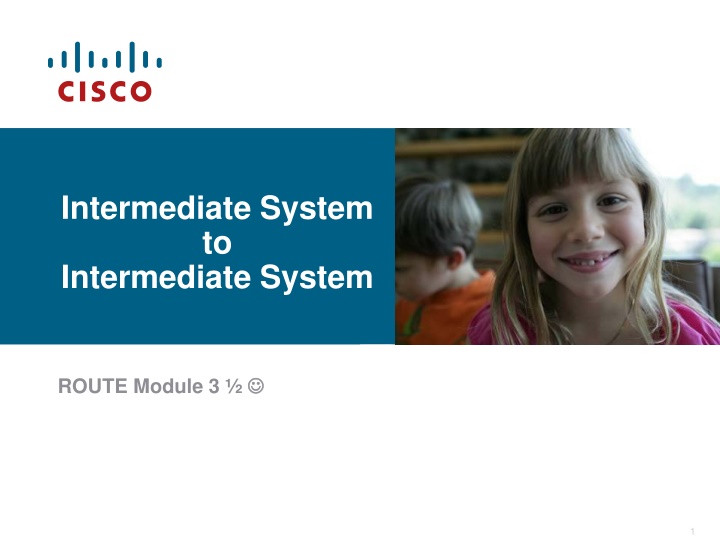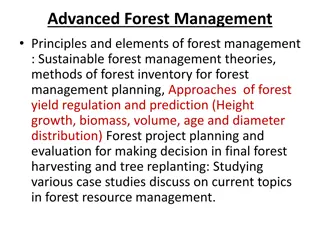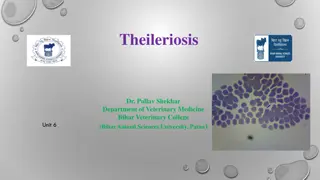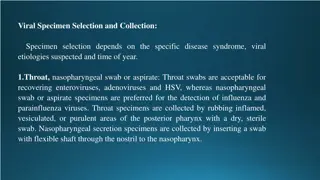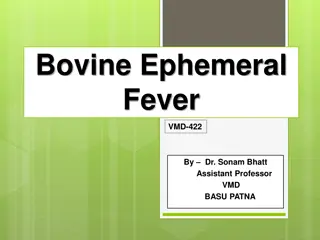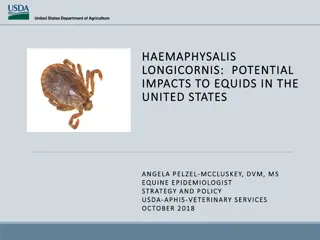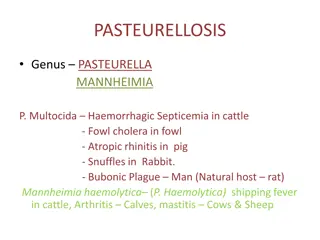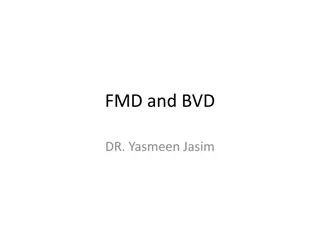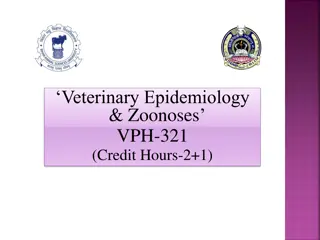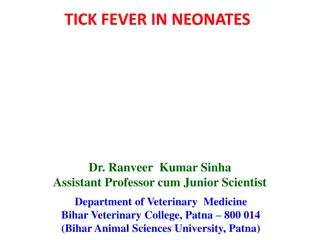Kyasanur Forest Disease: Tick-Borne Viral Haemorrhagic Fever
Kyasanur Forest Disease (KFD) is a tick-borne viral haemorrhagic fever caused by the Flavivirus. It was first identified in 1957 in the Kyasanur forest area of Karnataka. The disease affects both humans and animals, with monkeys acting as a major amplifier of the virus. The transmission occurs through infected ticks, primarily Haemaphysalis spinigera. KFD is prevalent in certain endemic areas of southern India, with cases reported between January to June. Understanding the epidemiology and natural cycle of KFD is crucial for effective prevention and control strategies.
Download Presentation

Please find below an Image/Link to download the presentation.
The content on the website is provided AS IS for your information and personal use only. It may not be sold, licensed, or shared on other websites without obtaining consent from the author.If you encounter any issues during the download, it is possible that the publisher has removed the file from their server.
You are allowed to download the files provided on this website for personal or commercial use, subject to the condition that they are used lawfully. All files are the property of their respective owners.
The content on the website is provided AS IS for your information and personal use only. It may not be sold, licensed, or shared on other websites without obtaining consent from the author.
E N D
Presentation Transcript
Intermediate System to Intermediate System ROUTE Module 3 1
Agenda OSI Introduction IS-IS Basics Configuration Troubleshooting 2
OSI Networks Interesting computer networks evolution during 70s/80s: US DoD developed Network Control Program that was later replaced by TCP/IP stack Meantime ISO tried to develop and introduce own ISO/OSI stack TCP/IP was successful because of easy understanding and quick implementation ISO delayed itself by unnecessary formalisms, high-level abstract protocols/interfaces and slow standardization process ISO protocols are complicated! Nowadays ISO could be still found in telcos networks but they have never been widely deployed 4
OSI Routing Multiple routing protocols were proposed for OSI ES-IS: routing between end-station and its gateway IS-IS: routing between routers in one AS a.k.a. domain in ISO terminology IDRP: routing between domains (analogous to BGP) Properties of IS-IS turn out to be sophisticated and flexible IS-IS was proposed and functional before OSPF, OSPF started as just a lite version of IS-IS During migration from OSI to IP it was suitable to have routing protocol capable of using both stacks RFC 1195 integrated extension to cooperate with IP without redefining basic structure of protocol 6
OSI Terms End System (ES): end station, host (PC) Intermediate System (IS): router Area: the set od interconnected ESs and ISs sharing same topology information Domain: the set of interconnected areas (same as AS) Routing levels: Level 0: routing among ES and IS Level 1: routing inside the one area Level 2: routing among areas inside the one domain Level 3: routing among domains 7
Node Identifiers and Its Interfaces Node address in OSI networks contains domain number, area number, node identifier and particular service on it Node has L3 address as a unit not as for each interface Network Service Access Point (NSAP) OSI address name Abstract point between network and transport layers NSAP has variable length in range from 8 to 20 B NSAP Selector (NSEL) The last byte of NSAP Identifier of network service IF NSEL == 0 THEN it is called Network Entity Title (NET) Only NET are assigned when configuring IS-IS router 9
NSAP Address 10
Node Address NSAP/NET addresses should be read from right to left 49.0001.1234.5678.9012.00 The most right byte: NSEL The next 6 bytes: System ID The remaining bytes except the last one: HO-DSP, IDI their length and semantics is specified by AFI The most left byte: AFI, for private domains reserved 49 System ID MUST BE unique among Level1 routers inside one area among Level2 routers inside one domain The best case is when System ID is unique for any router inside domain 12
Node Interface Each and every node interface is identified by SubNetwork Point of Attachment (SNPA) L2 identity of interface Ethernet: MAC address Frame Relay, ATM, X.25: DLCI HDLC and PPP Router mark each interface with Circuit ID for internal purposes 1 B long number (some IS-IS extensions uses larger space) Assigned by system itself automatically and it CAN NOT be changed via any configuration Multiaccess segment has number that is composed of System ID of Designated IS (analogy of OSPF DR) and its Circuit ID for this segment 13
IS-IS Basics 14
IS-IS Routing Protocol IS-IS is link-state protocol just like je OSPF, except it is completely different than OSPF IS-IS was originally designed for OSI networks Later it was integrated with IPv4 and IPv6 support Current IS-IS implementation supporting multiple address families are called Integrated IS-IS Integrated IS-IS is classless for IPv4 and it supports summarization, authentication, fast-convergence, area partitioning and much mode 15
Metrics IS-IS defines 4 different types of metric Default Expense (financial costs for data transfer across the link) Delay Error (error rate on the link) Cisco implementation supports only default metric type Moreover, default value of this Cisco implementation Default metric is not connected to any property of the link On every interface it is fixed to value 10 Hence, it is wise to change it according to real situation 16
Messages IS-IS messages are carried directly in data-link frames It does not use any transport protocol! It is address family agnostic which means that it is independent on transport protocol 17
Message Types IS-IS has four message types Hello packet Link-state PDU (LSP) Complete Sequence Number PDU (CSNP) Partial Sequence Number PDU (PSNP) Hello packet a.k.a IIH (IS-IS Hello) Sent every 10 seconds Designated IS sends it 3 faster (by default every 3.3 seconds) Timeout is 3 Hello interval There are two different Hello packets for Level1 and Level2 routing multiaccess networks Only one type of Hello paketu for point-to-point networks In RFC are mentioned also ESH and ISH they exchanged between ES and IS 18
Hello Packets End-stations inform routers about their existence with ESH (ES Hello) in OSI networks Same thing DOES NOT exist in IP networks! Routers send ISH (IS Hello) to inform end-station about their existence Routers exchange IIH (IS-IS Hello) 19
LSP Link-State PDU / Link-State Packet (LSP) Generovan ka d m routerom, pr buzn LSA z OSPF Obsahuj topologick inform ciu o routeri, jeho rozhraniach, ES dostupn ch cez tento router, v pr pade IP siet aj zoznam priamo pripojen ch IP siet LSP s slovan od 0x00000001 po 0xFFFFFFFF ivotnos dajov (RemainingLifetime) v LSP je 1200 sek nd (20 min t), periodicky sa obnovuj ka d ch 15 min t Ak nepr de aktualizovan LSP po 20 min tach, inform cie zo star ho LSP sa e te 1 min tu (ZeroAgeLifetime) ponechaj v datab ze, odstr nia sa a po jej uplynut Ak slo LSP dospeje do 0xFFFFFFFF, jeho autor mus vy ka aspo 21 min t, aby LSP expirovalo z datab z, a m e sa vr ti na po iato n hodnotu 20
PSNP and CSNP Partial/Complete Sequence Number PDUs Ich funkcia je pr buzn DDP/LSR/LSAck paketom z OSPF Pomocou PSNP je mo n potvrdi alebo vy iada si konkr tne LSP Na broadcastov ch sie ach sa nepotvrdzuje ka d rozposlan LSP, naopak, Designated IS router posiela ka d ch 10 sek nd pln zoznam LSP zo svojej datab zy pomocou CSNP Ak niektor router zist , e v CSNP ch ba LSP, ktor je routeru zn me, alebo je spomenut star ie LSP, router rovno po le nov LSP Ak router zist , e CSNP obsahuje info o LSP, ktor router nem , vy iada si ho prostredn ctvom PSNP 21
IS-IS Network Types IS-IS natively supports following network types Broadcast e.g. Ethernet Point-to-Point e.g. PPP IS-IS does not have special support for NBMA NBMA network could be transformed to multiple point-to- point connections E.g. Create special subinterface with own IP network for each DLCI as in case of Frame Relay IS-IS could be run over NBMA but full mesh connectivity MUST be guaranteed 22
IS-IS a siete typu Broadcast Podobne ako v OSPF, IS-IS si na broadcastov ch sie ach vol tzv. Designated IS (DIS) Router s najvy ou IS-IS prioritou bude DIS (priorita je tandardne 64 v rozmedz od 0 po 127) Ak je tak chto routerov viac, potom router s najvy m SNPA bude DIS Nie v etky rozhrania maj SNPA, alebo nie je mo n vedie SNPA suseda! Ak je tak chto routerov viac, potom router s najvy m SystemID bude DIS Vo ba je preempt vna a udeje sa v dy, ke sa zjav router s vy ou prioritou (resp. rovnakou prioritou a vy m SNPA), ne m s asn DIS Koncept z lo n ho DIS neexistuje lohou DIS je Vytvori LAN ID siete ( = System ID.Circuit ID ) Generova CSNP do broadcastovej siete Vytvori tzv. pseudonode Rozdiel od OSPF: v IS-IS s v etky routery na segmente kamar ti (adjacent), synchroniz cia je dan pr ve cez CSNP 23
Pseudonode for Broadcast Networks Pseudonode is fictive network node that abstracts topology on broadcast segment All ? neighbors on segment communicates with this pseudonode (? separate connections) instead of creating ?.? 1 each other DIS generates LSP describing pseudonode apart from its own LSPs This approach is used also by OSPF Pseudonode LSP is similar to OSPF LSA2 connections with 2 25
rovne smerovania v IS-IS IS-IS zabezpe uje smerovanie na rovniach Level1 a Level2 IS-IS smerova z rove posiela aj ISH, ale to nie je staros ou protokolu IS-IS Pre ka d rove s v IS-IS generovan osobitn verzie paketov a ukladaj sa do nez visl ch LSDB Level1 Smerovanie vo vn tri oblasti Obsahuje inform cie o topol gii samotnej oblasti (vytv ra graf s vyu it m SystemID uzlov a v om lokalizuje najkrat ie cesty) Pre IP: siete v aktu lnej oblasti Level2 Smerovanie medzi oblas ami Vymie a si adresy oblast (prefixy) a h ad k nim najkrat ie cesty Pre IP: siete a sum rne siete zo v etk ch oblast 26
rovne smerovania v IS-IS Router m e by Level1, Level2 alebo Level1-2 Pod a toho si vedie pr slu n datab zu a vytv ra adjacencies s okolit mi routermi Dva susedn routery musia podporova aspo jednu spolo n rove smerovania, inak nevytvoria adjacency S visl postupnos routerov so schopnos ou Level2 smerovania tvor chrbticu dom ny sl i pre medzioblastn (inter-area) smerovanie Chrbtica m e by len jedna Chrbtica mus by s visl 27
Oblasti v IS-IS Identifik tor oblasti je s as NSAP/NET Ke e router m jedno NET, patr ako celok pr ve do jednej oblasti Vo v nimo n ch pr padoch je mo n na jednom routeri nastavi viac NET (na Cisco routeroch max 3) Pou va sa pri migr cii medzi CLNS adresov mi priestormi Datab zy pre jednotliv NET sa navz jom zlej dohromady Hranice oblast s nevyhnutne teda na link ch Oblasti mus sp ja s visl re az routerov so schopnos ou smerovania Level2 28
Oblasti v IS-IS Level1 routery si v LSP oznamuj topol giu vlastnej oblasti Level2 routery si v LSP oznamuj oblasti, ktor poznaj a sp jaj Level1-2 routery sl ia ako hrani n smerova e medzi Level1 a Level2 smerovan m 29
Oblasti v IS-IS Oblasti v IS-IS nemaj typy ako v OSPF, av ak svoj m spr van m niektor typy pripom naj Level1 smerova e v oblasti bud ma inform cie iba o oblasti samotnej. Siete z ak chko vek in ch oblast bud nahraden pomocou default route. Level1 m u importova aj cudzie smery. Toto spr vanie pripom na NSSA Totally Stubby Level1-2 smerova e v oblasti bud ma inform cie o oblasti samotnej, ako aj o sie ach v in ch oblastiach. Samozrejme, m u importova aj cudzie smery. Toto spr vanie pripom na ABR smerova e Level2 smerova e poznaj siete vo v etk ch oblastiach. Toto spr vanie pripom na be n regul rnu oblas Prenos IP smerovacej inform cie: Level2-capable router prid va do svojej Level2 LSDB v etky svoje priamo pripojen IP siete a v etky IP siete zo svojej oblasti 30
Porovnanie OSPF a IS-IS OSPF Integrated IS-IS Hranice oblast s tvoren routermi (ABR) Hranice oblast le ia na link ch Ka d spoj (link) je pr ve v 1 oblasti Ka d router je pr ve v 1 oblasti Chrbtica sa roz iruje zlo itej ie Chrbtica sa roz iruje pomerne jednoducho Posiela sa mnoho mal ch LSA Posiela sa menej LSP Pracuje nad IP Be nad linkovou vrstvou Vy aduje IP adresy Vy aduje IP aj CLNP adresy Metrika je proporcion lna r chlosti rozhrania tandardn metrika 10 je kon tantne na v etk ch rozhraniach N ro ne sa roz iruje o nov funkcie ahko sa roz iruje o nov funkcie v aka TLV form tu spr v Zariadenia, person l a inform cie s dostupnej ie Zariadenia, person l a inform cie s hor ie dostupn 32
Requires NET Addresses A Common CLNS parameters (NET) and area planning are still required even in an IP environment Even when Integrated IS-IS is used for IP routing only, routers still establish CLNS adjacencies and use CLNS packets 34
OSI Area Routing: Building an OSI Forwarding Database (Routing Table) When databases are synchronized, Dijkstra s algorithm (SPF) is run on the LSDB to calculate the SPF tree The shortest path to the destination is the lowest total sum of metrics Separate route calculations are made for Level 1 and Level 2 routes in Level 1-2 routers Best paths are placed in the OSI forwarding database (CLNS routing table) 35
Building an IP Routing Table Partial Route Calculation (PRC) is run to calculate reachability Since IP and ES are represented as leaf objects, they do not participate in SPF Best paths are placed in the IP routing table following IP preferential rules They appear as Level 1 or Level 2 IP routes 36
Integrated IS-IS Configuration Steps 1. Define areas, prepare addressing plan (NETs) for routers, and determine interfaces 2. Enable IS-IS on the router 3. Configure the NET 4. Enable Integrated IS-IS on the appropriate interfaces. Do not forget interfaces to stub IP networks, such as loopback interfaces (although there are no CLNS neighbors there) These are each explained in the next few slides. 37
Integrating IS-IS Routing Command Description Enables IS-IS as an IP routing protocol and assigns a tag to the process (optional). Given in the global configuration mode. Identifies the router for IS-IS by assigning a NET to the router. Given in the router configuration mode. Enables IS-IS on the interfaces that run IS-IS. (This approach is slightly different from most other IP routing protocols, where the interfaces are defined by network statements; there is no network statement under the IS- IS process.) Given in interface configuration mode. router isis [area-tag] netnetwork- entity-title ip router isis [area-tag] 38
Step 1: Define Area and Addressing Area determined by NET prefix: Assign to support two-level hierarchy Addressing: IP:Plan to support summarization. CLNS: Prefix denotes area. System ID must be unique Recommanded way of generating SystemID: Create Loopback address on each router Convert IP address of Loopback: 10.15.134.7 010.015.134.007 0100.1513.4007 39
Step 2: Enable IS-IS on the Router Step 3: Configure the NET Router(config)# router isis [area-tag] Enable the IS-IS routing protocol. area-tag name for a process When routing of CLNS packets is also needed, use the clns routing command. Router(config-router)# net network-entity-title Configure an IS-IS NET address for the routing process. 40
Step 4: Enable Integrated IS-IS router(config-if)# ip router isis [area-tag] Includes an interface in an IS-IS routing process There is no network command for IS-IS!!! Configuration snippet: interface FastEthernet0/0 ip address 10.1.1.2 255.255.255.0 ip router isis ! interface Serial 0/0/1 ip address 10.2.2.2 255.255.255.0 ip router isis ! router isis net 49.0001.0000.0000.0002.00 41
Simple Integrated IS-IS Example The configured router acts as an IP-only Level 1-2 router. interface FastEthernet0/0 ip address 10.1.1.2 255.255.255.0 ip router isis ! interface Serial 0/0/1 ip address 10.2.2.2 255.255.255.0 ip router isis ! <output omitted> router isis net 49.0001.0000.0000.0002.00 42
Change IS-IS Level Router(config-router)# is-type {level-1 | level-1-2 | level-2-only} Configure the IS-IS level globally on a router; the default is level 1-2. Router(config-if)# isis circuit-type {level-1 | level-1-2 | level-2-only} Configure the type of adjacency on an interface; the default is Level 1-2. 43
Change IS-IS Metric Router(config-if)# isis metric metric [delay-metric [expense-metric[error-metric]]] {level-1 | level-2} Configure the metric for an interface; the default is 10 Metric value is from 1 to 63 Router(config-router)# metric default-value {level-1 | level-2} Alternately, configure the metric globally for all interfaces 44
Narrow and Wide Metrics Former IS-IS specification uses metrics that are: for interfaces 6 bits long (values in range from 1 to 63, 0 is reserved) for a whole path 10 bits long (max. value 1023) Those kind of so called narrow metrics are unsuitable for nowadays networks Currently IS-IS supports also wide metrics that are: 24 bits long for interface 32 bits long for whole path (some bits are reserved) It is suggested to enable wide metrics, but they should be configured on all IS-IS devices in the domain Otherwise routing loops might occur!!! 45
Changing Metric Types Router(config-router)# metric-style {narrow | transition | wide} [level-1 | level-2 | level-1-2] Previous command specifies the IS-IS metric type Option transition is used when migrating from narrow to wide metrics All routers in domain MUST use same type of metric 46
Tuning IS-IS Configuration Change router type on R1 and R3 Change interface levels on R2 Change metric on S0/0/1 47
IP Summarization Router(config-router)# summary-address address mask[level-1 | level-2 |level-1-2][tag tag-number] [metric metric-value] Creates summary and appropriate discard route Command applies only on the router that is actually importing routes into any ISIS topology database: any L1L2 router any router performing redistribution into IS-IS Level parameter specifies in which level summary is created Default is Level 2 Summary into L1 makes sense only in case of redis Configuration snippet to summarize 10.3.2.0/23 into L1-2: P3R1(config-router)# summary-address 10.3.2.0 255.255.254.0 level-1-2 48
Authentication: The Older Way interface FastEthernet0/0 isis password HESLO1 [level-1 | level-2] router isis area-password HESLO2 domain-password HESLO3 Beware only plain-text password!!! The command isis password appends password to all Hello packets (authenticates adjacencies) For point-to-point networks is password valid for both L1 and L2 For broadcast networks password could be different for L1 and L2 The command area-password defines password authenticating to Level1 LSP, PSNP a CSNP The command domain-password defines password authenticating Level2 LSP, PSNP a CSNP 49
Authentication: The New Way interface FastEthernet0/0 isis authentication mode {md5 | text} [level-1 | level-2] isis authentication key-chain KEYCHAIN router isis authentication mode {md5 | text} [level-1 | level-2] authentication key-chain KEYCHAIN Same way as in case of authentication process for distance vector protocols using keychains Per-interface commands specify authentication for Hello packets ISIS sub-configuration commands specify authentication for LSP, CSNP, PSNP Key numbers and key-string MUST match between neighbors 50
